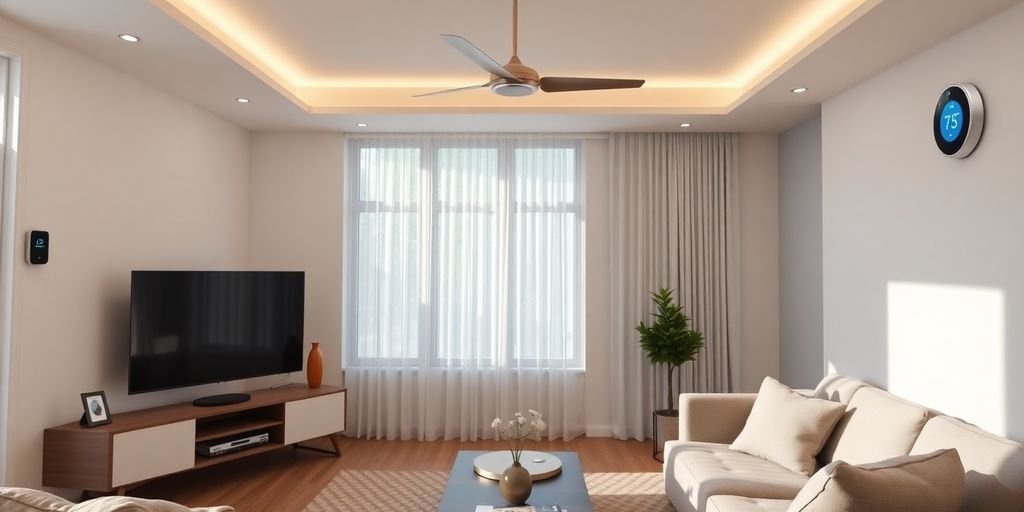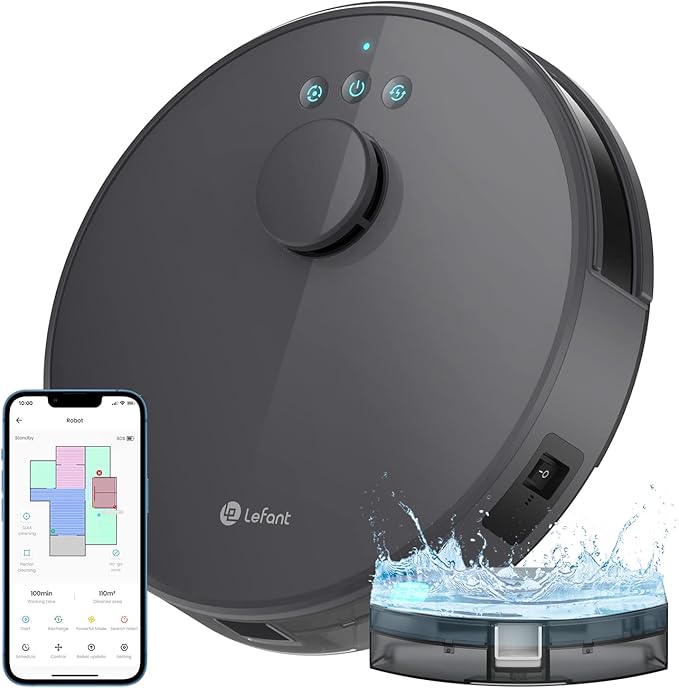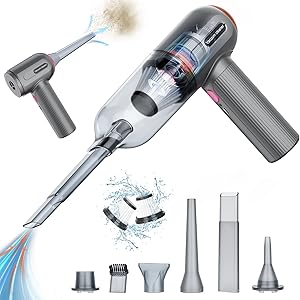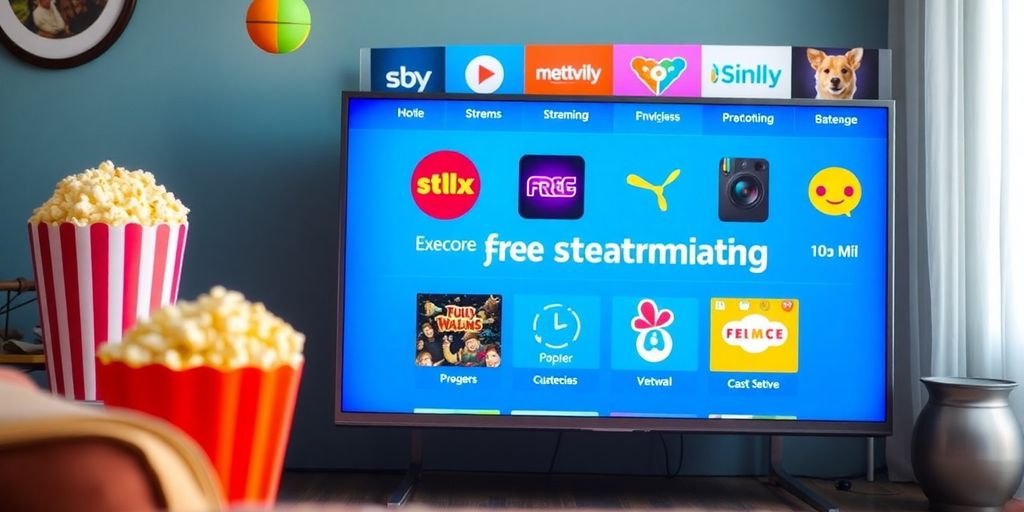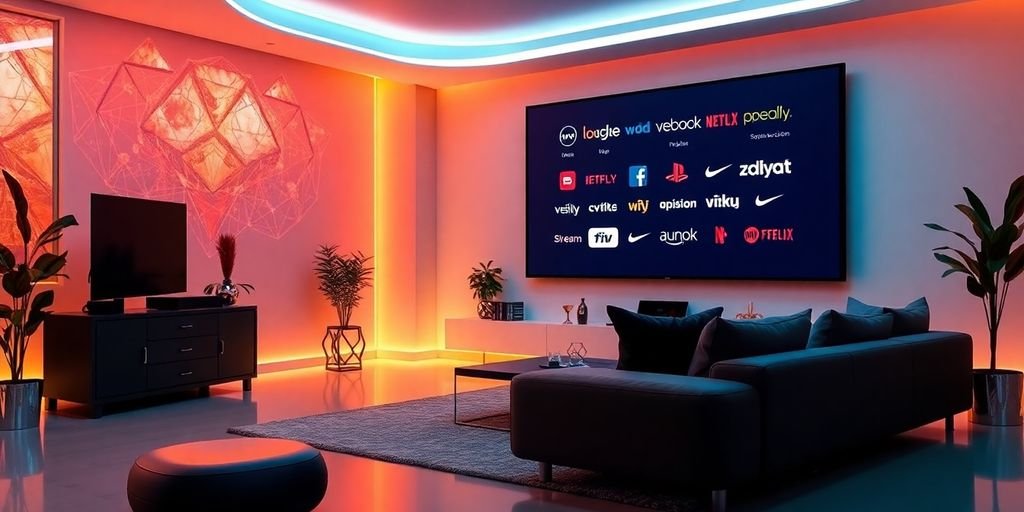Are you ready to upgrade your living space with the latest in smart home technology? The future is here, and it’s all about making our homes more intuitive and efficient. With smart devices, you can control everything from your lighting to your security systems with just a few taps on your phone or even your voice. This guide will explore the exciting innovations set to transform our homes in 2025, helping you create a living environment that caters to your lifestyle and needs.
Key Takeaways
- Smart home technology boosts convenience and energy savings.
- Integrating smart devices can enhance home security.
- Key elements of a smart home include lighting, thermostats, and security systems.
- When selecting devices, think about compatibility and your lifestyle.
- Keeping up with smart home trends helps in making informed choices.
Transform Your Home With Smart Technology

Understanding Smart Home Innovations
Smart home tech is changing how we live. It’s not just about fancy gadgets; it’s about making life easier and more efficient. Think about controlling your lights, heating, and security from your phone. Smart devices are becoming more common, and they’re designed to work together to create a connected home. It’s about integrating technology to suit your lifestyle.
Benefits of Smart Living
There are loads of reasons to go smart. For starters, it can save you money on energy bills. Smart thermostats learn your habits and adjust the temperature automatically. Plus, home security gets a major upgrade with smart cameras and door locks. And let’s not forget the convenience – controlling everything with your voice or a tap on your phone. It’s about making your home work for you, not the other way around.
- Energy savings through automated climate control.
- Enhanced security with remote monitoring.
- Increased convenience with voice-activated assistants.
Smart living isn’t just about having the latest tech; it’s about creating a home that’s more comfortable, secure, and efficient. It’s about adapting your living space to fit your needs and making everyday tasks simpler.
Integrating Smart Devices Into Your Home
Getting started with smart home tech can seem daunting, but it doesn’t have to be. Start small by picking a few key areas to focus on, like lighting or security. Make sure the devices you choose are compatible with each other. A centralised control hub can help manage everything from one place. And don’t forget about your Wi-Fi – a strong, reliable connection is essential for everything to work smoothly.
| Device | Functionality |
|---|---|
| Smart Thermostat | Automated temperature control, energy savings |
| Smart Lighting | Remote control, customisable scenes |
| Smart Security | Remote monitoring, alerts |
Home Automation Trends Shaping 2025
Energy Efficiency Solutions
Okay, so energy efficiency isn’t exactly new, but in 2025, it’s gone next level. We’re not just talking about turning off lights anymore. Smart thermostats learn your habits, motion-sensing lights only come on when needed, and HVAC systems predict when you’ll need heating or cooling. It’s all about cutting down on waste and saving money.
- Smart thermostats that adapt to your schedule.
- Lighting systems that respond to movement.
- Advanced heating and cooling with predictive tech.
Integrating renewable energy systems like solar panels is becoming more common, allowing homeowners to track energy production and usage in real time. This helps reduce waste and lower costs, promoting a sustainable lifestyle.
Customisation Through Smart Devices
Forget one-size-fits-all. In 2025, it’s all about making your home uniquely yours. Smart devices let you tweak everything from lighting to temperature with just your voice or a tap on your phone. These systems adapt to your lifestyle, ensuring your home feels perfect the moment you walk in.
- Voice-activated control of lights and thermostats.
- Voice-activated locks and alarms for enhanced security.
- Personalised routines for waking up and winding down.
Sustainable Living Innovations
Home automation in 2025 is blending sustainability and smart tech like never before. Imagine a home that thinks for itself and works to protect the planet. By integrating smart home systems with renewable energy sources, homeowners can track their energy production and usage in real time, slashing waste and cutting costs. It’s about making eco-friendly choices without sacrificing convenience. It’s not just a trend; it’s a responsibility.
Guidelines for Successful Smart Home Installation
Choosing the Right Devices
Okay, so you’re thinking about turning your place into a proper smart home? Brilliant! But before you go wild buying every gadget you see, let’s have a chat about picking the right stuff. It’s not just about getting the fanciest tech; it’s about what actually fits into your life and makes things easier. Think about what annoys you most around the house. Is it the heating bills? Maybe a smart thermostat is the way to go. Always forgetting to turn off the lights? Smart bulbs could be your saviour.
Here’s a quick checklist:
- What do you actually need? Don’t buy something just because it’s cool. Will it genuinely make your life better?
- Think about compatibility. Will this new gadget play nicely with your existing tech? Check if it works with your current smart home setup, if you have one.
- Read the reviews. See what other people are saying. Are there any common problems? Is the customer support any good?
Ensuring Compatibility
Right, you’ve got your shopping list sorted. Now, let’s make sure everything actually works together. This is where things can get a bit tricky. You don’t want to end up with a load of gadgets that refuse to talk to each other, do you? The key thing here is to check what "language" your devices speak. Some use Zigbee, some use Z-Wave, and some just use Wi-Fi. If you’re starting from scratch, it might be worth investing in a central hub that can handle multiple protocols. Think of it as a translator for your smart home.
It’s also worth checking if your devices work with your voice assistant of choice. If you’re an Alexa fan, make sure your new gadgets are Alexa-compatible. Same goes for Google Assistant and Siri.
Setting Up Your Smart Home Network
So, you’ve got all your shiny new gadgets, and they’re all compatible. Great! Now, let’s get them online. This is where your Wi-Fi comes in. A weak or unreliable Wi-Fi signal can ruin the whole experience. Imagine your smart lights flickering on and off, or your security camera cutting out just when you need it most. Not ideal, is it? Make sure your Wi-Fi is up to the job. If you’ve got a big house, or thick walls, you might want to consider a mesh Wi-Fi system. These create a network of Wi-Fi points around your home, ensuring a strong and stable signal everywhere. Once you’ve got your Wi-Fi sorted, it’s just a matter of following the instructions for each device. Most of them are pretty straightforward, but don’t be afraid to ask for help if you get stuck. There are loads of online tutorials and forums where you can find answers to common problems.
Revolutionising Security With AI Technology
Proactive Security Measures
AI is changing how we think about home security. Instead of just reacting to threats, AI-powered systems can anticipate them. This means your home isn’t just smart, it’s proactive. Imagine a system that learns your routines and recognises unusual activity, alerting you before a potential problem even arises. It’s like having a virtual security guard that never sleeps.
These systems use machine learning to analyse data from sensors, cameras, and other devices to identify patterns and anomalies. This allows them to detect potential threats with greater accuracy and speed than traditional security systems.
Facial Recognition Systems
Facial recognition is becoming a standard feature in smart home security. These systems can identify who is at your door or on your property, allowing you to grant access to trusted individuals and deny entry to strangers. Key innovations to watch include:
- AI-enhanced cameras that know who’s who
- Smart motion sensors that focus on what matters
- Remote-controlled locks for ultimate convenience
This technology isn’t just about convenience; it’s about enhanced home security. It can also be used to monitor the well-being of elderly or vulnerable family members, alerting you if they are not seen for an extended period.
Remote Monitoring Capabilities
One of the biggest advantages of AI-powered security is the ability to monitor your home from anywhere in the world. Whether you’re on holiday or simply at work, you can check in on your property and receive real-time alerts if anything suspicious is detected. This level of smart home automation provides peace of mind and allows you to take action quickly if necessary.
- View live video feeds from your security cameras.
- Receive instant notifications on your smartphone or tablet.
- Control your smart locks and other security devices remotely.
| Feature | Benefit |
|---|---|
| Remote Access | Monitor your home from anywhere |
| Real-Time Alerts | Get notified of suspicious activity |
| Smart Lock Control | Secure your home with a tap of your phone |
Centralised Control Hubs for Enhanced Management
Home automation is getting seriously streamlined, and it’s all thanks to centralised control hubs. Forget juggling multiple apps; these hubs let you manage everything from one place. It’s about making life easier, more efficient, and, let’s be honest, way less frustrating.
Streamlining Device Control
The beauty of a centralised hub is that it brings all your smart devices under one roof. No more switching between apps to dim the lights, adjust the thermostat, or check your security cameras. It’s all there, in one interface. This makes managing your smart home a breeze, whether you’re at home or away. Think of it as the conductor of your smart home orchestra, ensuring every device plays in harmony. For example, you can use Matter smart home hubs to control all your devices.
User-Friendly Interfaces
Let’s face it, some smart home interfaces can be a bit clunky. But the latest control hubs are all about user-friendliness. We’re talking intuitive layouts, customisable dashboards, and easy-to-understand settings. The goal is to make smart home management accessible to everyone, regardless of their tech skills. It’s about simplifying the complex and putting you in control.
Integrating Multiple Systems
One of the biggest advantages of centralised hubs is their ability to integrate multiple systems. This means you can connect your lighting, security, climate control, and entertainment systems, all to one hub. This level of integration allows for some seriously clever automation. Imagine your lights dimming automatically when you start a movie, or your thermostat adjusting when you leave for work. It’s about creating a truly connected and responsive home.
Centralised control hubs are not just about convenience; they’re about creating a more intuitive and responsive living environment. By bringing all your smart devices together, these hubs make it easier to manage your home and create a truly personalised experience.
Future-Proofing Your Smart Home
It’s easy to get caught up in the excitement of new gadgets, but how do you make sure your smart home stays smart for years to come? It’s all about planning and making smart choices now.
Staying Ahead of Technological Advances
Technology moves fast, doesn’t it? What’s cutting-edge today is old news tomorrow. To keep up, read tech blogs, attend online webinars, and maybe even subscribe to a tech magazine. The goal is to stay informed about what’s coming down the line. This way, you won’t be caught off guard when a new standard or device hits the market. Also, consider devices that can be updated with new software, so they don’t become obsolete quickly. For example, you can use an AI Base Station to keep your home up to date.
Investing in Versatile Devices
Think about buying devices that can do more than one thing. A smart speaker that also acts as a hub, or a security camera with environmental sensors, gives you more bang for your buck and reduces the number of individual gadgets you need to manage. Versatility is key. Also, look for devices that support multiple communication protocols (like Wi-Fi, Zigbee, and Z-Wave) so they can work with a wider range of other devices.
Planning for Upgrades and Expansions
Think of your smart home as a work in progress. You’ll probably want to add new devices and features over time. Make sure your network can handle the load. Consider a mesh Wi-Fi system to provide strong coverage throughout your home. Also, think about the placement of your devices. Can you easily add new ones without rewiring or rearranging everything?
It’s a good idea to create a budget for upgrades and expansions. This will help you stay on track and avoid overspending. Also, consider the long-term costs of ownership, such as subscription fees or replacement batteries.
Here are some things to consider when planning for upgrades:
- Network Capacity: Ensure your router can handle more devices.
- Power Outlets: Make sure you have enough outlets for new gadgets.
- Compatibility: Check if new devices will work with your existing system.
Smart Home Solutions for Everyday Convenience

Automated Lighting and Climate Control
Imagine a world where your lights adjust automatically as the sun sets, and your thermostat learns your preferred temperature settings. That’s the reality with automated lighting and climate control. Smart lighting enhances security by mimicking occupancy when you’re away, while smart thermostats optimise energy usage, saving you money on bills. It’s about creating a comfortable and efficient living space with minimal effort.
Voice-Activated Assistants
Voice-activated assistants have become an integral part of the modern home. These devices allow you to control various aspects of your home with simple voice commands. From playing music to setting reminders, and even controlling other smart devices, they offer unparalleled convenience. It’s like having a personal assistant at your beck and call, making daily tasks easier and more efficient.
Smart Appliances for Daily Tasks
Smart appliances are revolutionising how we approach daily chores. Think of refrigerators that can create shopping lists based on what’s running low, or ovens that can be controlled remotely.
Here are some examples:
- Smart washing machines that optimise wash cycles.
- Dishwashers that can be started remotely.
- Coffee makers that brew your morning coffee before you even get out of bed.
These appliances not only save time but also offer insights into your consumption habits, helping you to make more informed decisions and reduce waste. It’s about making life easier and more sustainable through technology.
Wrapping It Up: Your Smart Home Journey
So, there you have it. Turning your home into a smart haven isn’t just a trend; it’s a way to make life easier and more enjoyable. Whether you’re starting with a simple smart speaker or going all out with a full automation setup, every little bit helps. Once you get a taste of the convenience and security these gadgets bring, you won’t want to go back. Take your time, explore what’s out there, and find what fits your lifestyle best. Your home should be a place that works for you, so why not let technology lend a hand? Dive into the world of smart home products and see how they can transform your living space today.
Frequently Asked Questions
What is smart home technology?
Smart home technology includes devices that connect to the internet and can be controlled remotely. This makes it easier to manage things like lighting, heating, and security.
How can smart technology improve my home?
Smart technology can make your home more convenient, secure, and energy-efficient. For example, smart lights can turn on automatically, and smart thermostats can help save on energy bills.
Are smart devices easy to install?
Most smart devices are designed for easy installation. Many come with step-by-step instructions, and some can be set up using a smartphone app.
Do I need a special network for smart devices?
You usually need a reliable Wi-Fi connection for smart devices to work properly. Some devices might require a specific hub to connect everything.
Can smart home devices work together?
Yes, many smart devices can work together through a central hub or app, allowing you to control everything from one place.
What should I consider when buying smart home devices?
When buying smart home devices, think about how they will fit into your daily life, their compatibility with other devices, and whether they meet your specific needs.

